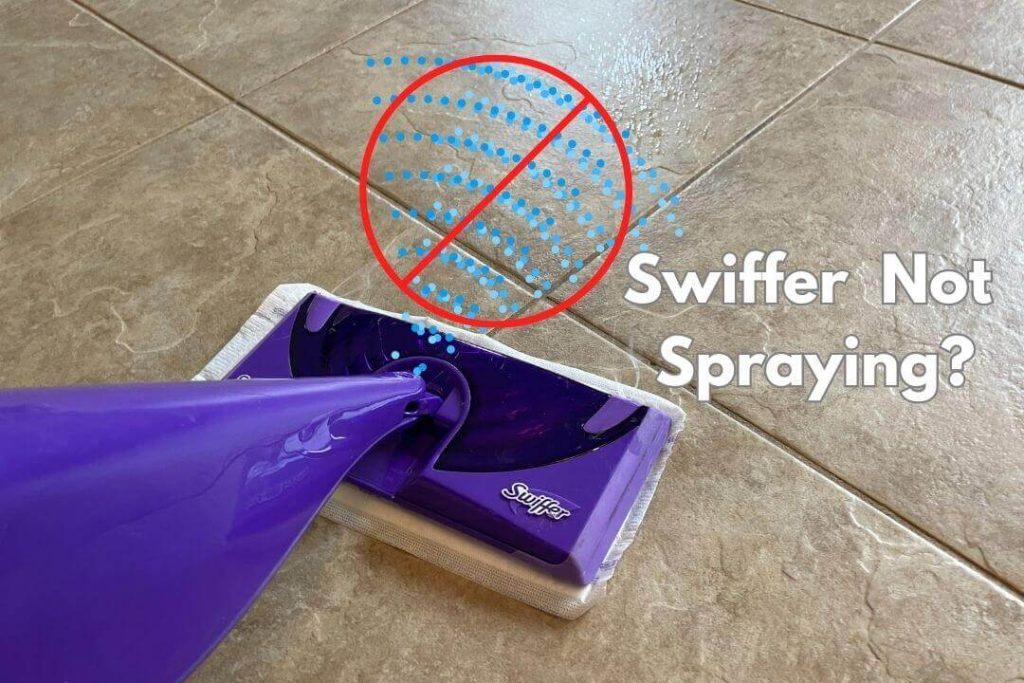Few things are more frustrating than grabbing your Swiffer WetJet, pulling the trigger, and… nothing happens. Maybe you hear no motor sound, or maybe it hums but no spray comes out. The good news is that most problems are quick fixes—you don’t need to throw your mop away just yet.
This guide walks you through the most common reasons a WetJet stops spraying and shows you exactly how to fix it. We’ll start with the fastest checks, then move into deeper solutions, so you don’t waste time guessing.
Quick Answer
If your Swiffer WetJet won’t spray:
- Check the batteries – replace all 4 AA batteries with fresh ones.
- Re-seat the solution bottle – push it in until it clicks.
- Prime the sprayer – pull the trigger 10–15 times to move air out of the line.
- Wipe the nozzles – dried cleaner often blocks the spray.
If you hear the motor but see no spray, it’s likely a clog (fixes later in this guide). If you hear no sound at all, start with batteries and bottle placement.
Fast Diagnostic: Do You Hear a Motor Sound?
Before diving into fixes, the easiest way to know where to start is by listening. Pull the trigger and pay attention:
- Yes, you hear a humming sound → The motor is running, but solution isn’t coming out. This usually means a clog, an airlock, or a bottle valve issue. Skip ahead to the cleaning and unclogging fixes.
- No, there’s no sound at all → The unit isn’t getting power. Focus on the battery setup, battery contacts, or the trigger connection.
- Sometimes it works, sometimes it doesn’t → That points to a loose bottle, weak batteries, or sticky trigger. You’ll want to check both the power side and the spray ports.
This quick sound test saves time—you don’t have to try all 11 fixes in random order.
11 Fixes That Actually Work
1. Confirm Battery Orientation
Open the battery compartment on the handle. Make sure each AA battery is aligned with the plus and minus signs. Even one reversed battery will stop the motor.
2. Install Fresh Batteries
Swap in four brand-new AA alkaline batteries. Don’t mix old and new ones, as uneven power can cut off the motor.
3. Reset the Trigger Path
Take the batteries out. Hold the spray trigger down for 10 seconds to clear any leftover charge. Reinstall the batteries and test again.
4. Seat the Solution Bottle Correctly
Flip the bottle upside down and push it into the slot until you hear a solid click. If it’s not seated, the pump can’t pull cleaner into the sprayer.
5. Prime the Pump
Sometimes air gets trapped in the line. Hold the mop at a slight angle and pump the trigger 10–15 times until the mist appears.
6. Clean the Spray Nozzles
Dried cleaner often clogs the ports. Wipe both nozzles with a damp cloth. If buildup is stubborn, press a warm, wet towel over the tips for 1–2 minutes, then test again.
7. Clear Sticky Residue
If liquid dried inside the spray ports, use a wooden toothpick gently to loosen it. Avoid metal pins—they can damage the nozzle.
8. Try a Different Solution Bottle
Sometimes the valve in the bottle is faulty or cracked. Swap in a new Swiffer solution bottle to see if spraying returns.
9. Check the Trigger Movement
Make sure the trigger springs back after each pull. If it sticks, press and release a few times. Clear away any dirt or residue around the trigger slot.
10. Clean Battery Contacts
Open the battery compartment and look at the metal contacts. If they look dull or rusty, wipe with a dry cloth. For tougher spots, use a cotton swab with a drop of rubbing alcohol, then let dry before reinserting batteries.
11. Know When to Replace
If you’ve tried all steps and the motor still won’t run—or the unit sprays once then dies—it may be a motor failure. At this point, contact Swiffer support if it’s under warranty, or replace the mop.
Why It Happens
When your Swiffer WetJet stops spraying, it usually comes down to a few common issues:
- Airlock – A new solution bottle can trap air in the line, stopping the flow.
- Clogged nozzles – Dried cleaner around the spray tips blocks the mist.
- Weak or misaligned batteries – Power cuts off if the batteries are old or inserted the wrong way.
- Loose bottle connection – If the bottle isn’t fully clicked in, the pump can’t pull fluid.
- Long storage or heavy use – Dust, residue, or corrosion builds up over time, slowing the sprayer.
Prevention
A few small habits can keep your WetJet running smoothly:
- Store upright – prevents leaks and air bubbles in the line.
- Wipe nozzles after each use – stops cleaner from drying and clogging.
- Change pads often – dirty pads push residue back toward the sprayer.
- Remove batteries for long breaks – avoids corrosion and weak power starts.
- Stick to Swiffer solutions – DIY refills may clog the pump or damage the bottle valve.
With these quick habits, you’ll save yourself from mid-clean surprises and extend the life of your WetJet.
Full Troubleshooting Checklist
If your Swiffer still isn’t spraying after trying the fixes above, run through this step-by-step checklist to make sure nothing was missed:
- Check the solution bottle – Is it full, clicked into place, and free of leaks?
- Inspect for visible leaks – Look around the connection point and mop head for drips.
- Replace the batteries – Use four fresh AA alkaline batteries, inserted correctly.
- Test the trigger – Make sure it springs back and engages the pump.
- Unclog the nozzles – Soak in warm water and clear debris with a pin if needed.
- Prime the pump – Hold the Swiffer downward and spray repeatedly to remove air bubbles.
- Check seals – Make sure the bottle and intake port are clean and undamaged.
- Listen for motor noise – If the motor isn’t running at all, it could be an electrical fault.
- Contact Swiffer support – If your unit is under warranty, they may replace it.
When to Replace Your Swiffer
If your mop is several years old, heavily used, and none of these steps restore function, replacing it may be more cost-effective than repairing it — especially since parts like the pump and trigger aren’t sold separately.
FAQs
Why is my brand-new Swiffer WetJet not spraying?
New units often need priming. Seat the solution bottle until it clicks, then pump the trigger 10–15 times. This clears air from the line.
What if I hear the motor but no spray comes out?
That usually means clogged nozzles or an airlock. Wipe the spray tips, hold a warm damp towel on them for a minute, and try again.
Why won’t my WetJet make any sound?
No sound means no power. Replace all 4 AA batteries, check orientation, and clean the battery contacts before testing again.
Why does my WetJet spray on one side only?
One nozzle is likely blocked. Clean both tips with a damp cloth and gently loosen buildup with a wooden toothpick.
Can I use plain water instead of solution?
No. The WetJet pump is designed for Swiffer solutions only. Water or homemade mixes can clog the sprayer and void the warranty.
Why does it spray once and then stop?
This happens when the pad is oversaturated or the bottle isn’t clicked in fully. Replace the pad and reseat the bottle.
How long should one solution bottle last?
On average, a 1.25L bottle lasts 8–10 full cleans, depending on room size and how much you spray.
Conclusion
A Swiffer WetJet that won’t spray can be annoying, but in most cases, it’s a simple fix. Fresh batteries, a properly clicked-in bottle, or a quick nozzle clean usually bring it back to life in minutes. And if you keep up with small habits—like wiping nozzles and storing it upright—you’ll avoid most spray problems in the future.
If your WetJet still won’t work after trying all 11 fixes, it may be a motor issue, and replacing the unit is the most practical option.

